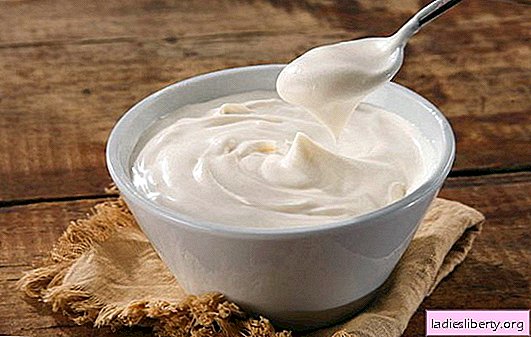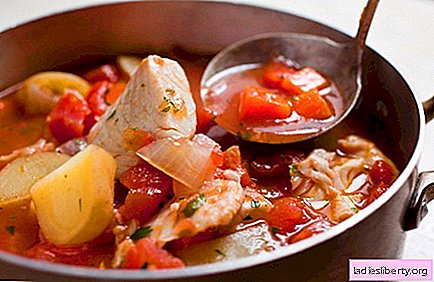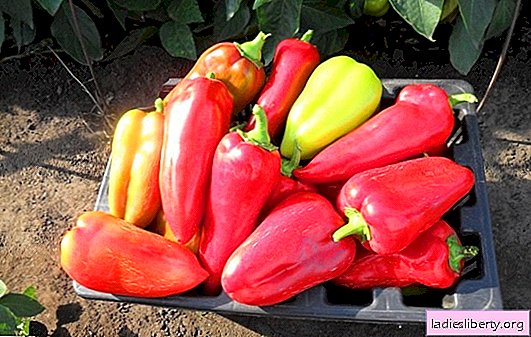
People have been making homemade sour cream since they tamed cows, goats and sheep and began to receive milk from them.
Since then, the production of fermented milk product has not changed significantly, except for the improvement of the technological process.
How to make sour cream at home - the basic technological principles
Probably, every taste of sour cream has its fans.
Someone prefers a low-fat product, with a sour taste, from a supermarket, in a beautiful original packaging, and someone likes home-made sour cream, in a rustic way, like grandma, in childhood.
In many private farms, they still make sour cream the old-fashioned way, by fermenting milk and collecting the fat part that has risen to the surface.
In farms where milk production is more substantial, stable, and sour cream is constantly being sold on the market, there are domestic separators that facilitate the process of making cream for home-made sour cream. But even this method, although partially mechanized, is still far from the technological process in a large dairy processing plant.
Here it should be noted that the quality of farmer sour cream most often exceeds the products of large manufacturers, since the conditions for its production are more close to the natural ones.
It is unlikely that it will be possible to reproduce the entire technological chain of production of sour cream at home, even without taking into account the packaging, but an understanding of the essence of the technology and all its stages will help to achieve the most approximate result, especially if you want to have a fresh homemade product with properties close to factory-made sour cream.
Of course, the most important role in the manufacture of sour cream is feedstock - milk. Since cow's milk is still the most traditional and popular raw material for sour cream, and the technology of sour cream from the milk of other domestic animals is difficult even for production conditions, we’ll focus on the first option.
The quality of sour cream can depend on many factors, and its fat content is directly proportional to the fat content of the original product. From this it follows that from skimmed or low-fat milk it is impossible to get sour cream, even with a low percentage of fat content. The minimum fat content of sour cream is 10%, and the maximum - 58%. In homemade sour cream fat content can reach 75%.
Of course, fatty food, from the point of view of nutrition, is harmful, and it is difficult to disagree. But if you do not forget about the sense of proportion, the harm of a natural product is nothing compared to the benefit of a dietary analogue created artificially.
After all, it is no secret that often, buying sour cream, you have to face some incomprehensible moments:
date of manufacture and sale: sour cream, as a natural fermented milk product can not be stored for more than 5 days. How can a natural fermented milk product be preserved for more than a month?
composition: natural cream, except cream and yeast, can not contain any other components. At this point, sometimes the manufacturer, in general, shows the wonders of ingenuity;
and, if you are already strictly considering the issue, then storage of this product in plastic or cardboard is also unacceptable;
if it is written on the package that the fat content is 10% and the consistency is thick, such a purchase should also be abandoned, or to finally make sure that the sour cream product is not only not useful, but even harmful to health, bring the package home and conduct an experiment : add 1-2 drops of iodine to a spoonful of sour cream. If the product turns blue, then, in addition to the fermented cream, it contains something else, about which the manufacturer "modestly" kept silent;
quite often in retail chains there is “sour cream” with non-dissolving grains. This only means that there is no longer any benefit from such sour cream, except for its presence on the table. Often, in such products there is not even a trace of cream, and natural products are replaced by artificial ones. How can an artificial component organically interact with natural enzymes involved in digestion?
Our ancestors did not have measuring instruments to determine the fat content of sour cream, to rank it among a variety of dietary products, so ideas about the properties and benefits of products were the result of centuries-old observations and personal experience.
Didn’t anyone notice that fat milk or cream causes a feeling of heaviness in the body, while sour cream is easily digested? The fact is that as a result of the natural souring of fresh cream, natural milk proteins and fats pass into another biochemical state, most suitable for digestion.
Of course, one should not reject too categorically the proposals of large dairy producers, because among them there are many conscientious sellers of milk processing services. At least, to learn how to make sour cream at home you can take their experience into service.
In short, the production stages that meet the requirements of GOST are in successive stages, which can be partially reproduced in the manufacture of home-made sour cream. Let us try to list these stages, at the same time finding ways to reproduce them at home.
1. Milk collection. This stage is the same at any enterprise: the purchase of milk from the population, with accompanying laboratory tests, in order to determine the fat content of milk and to identify (exclude) the possible presence of harmful bacteria.
2. Separation of raw milk. Cream is separated from the collected natural milk. But first they are kept initially at a rather low temperature (4ºϹ), and then heated (up to 40ºϹ) in order to increase the plasticity of milk fats and improve their separation from milk protein during separation.
3. Normalization. This production stage without special, rather complicated, and unsuitable for domestic purposes, equipment, at home is not feasible. The purpose of this stage in the production environment is the redistribution of the percentage of fat in the feedstock for the production of sour cream of different fat content.
4. Pasteurizationduring which heated separated cream reduces the viscosity of the fat. This is possible at a temperature of 62ºϹ. In addition, the temperature regimes in the manufacture of sour cream are established in a certain relationship with the activation and suppression of the activity of lactic acid bacteria, which are contained in raw milk and are involved in the sour cream souring.
5. Homogenization. The essence of the process consists in crushing larger fat molecules that are naturally separated from protein. Fat splitting is achieved by heating and extruding the raw material. That is, warm cream is passed through a narrow tube under high pressure. This operation helps to change the cream and get a more homogeneous mass, which, after ripening, does not split into serum and clot. At this stage, the temperature of heating increases to 90ºϹ, the pathogenic environment is destroyed.
6. Leaven. Adding a certain group of lactic bacteria, which are used specifically for the production of sour cream (thermophilic yeast), starts the process of fermentation. The favorable temperature for the growth and development of thermophilic yeast is approximately equal to the normal temperature of a person and for 10 hours it is maintained so that the lactic acid bacteria can spread in the mass of pasteurized raw materials.
7. Exposure or ripening. Already prepared sour cream is shipped to cooler chambers, with a temperature not higher than 8ºϹ, where it matures for at least 14 hours, before the onset of the packaging and subsequent sale. In some cases, sour cream is packed in the process of ripening and at the same time it is partially cooled in order for the sour cream to ripen.
How to make sour cream at home, knowing all the major technological points?
First you need to buy whole milk. It is advisable to do this in a market where the sanitary doctor and the epidemiological laboratory check the products before being approved for sale. An alternative step is to buy milk from a familiar farmer. Pay attention to the purity of the container and the tidiness of the seller. Milk fat can be determined visually. 3-4 hours after milk yield, the lighter milk fats are separated from the protein and float to the surface of the bottle. They have a cream color, and the border between proteins and fats is clearly marked. In milk, with a high content of fat content, up to 1/3 of the fat per 3 liters of the total volume. This means that milk contains at least 30% fat, and from it you can get high-quality cream and sour cream. It is enough to lower the bottle, for example, a plastic tube from the medical injection system, and transfer the lower, protein part of the milk to another can, which is at a lower level at this time. In this case, the milk will contain a sufficient amount of fat and can be used for any purpose.
If there is a household separator, then you can separate a greater amount of milk fat for making homemade sour cream, but the remaining milk (reverse) will be skimmed. Nevertheless, the reverse is also suitable for culinary processing and eating, as it contains the valuable composition of vitamins and minerals.
In the absence of a separator, before making sour cream at home, natural milk is better to warm up in any case. If you plan to ferment sour cream in a natural way, then the heating should not exceed 42ºϹ. During pasteurization, natural bacteria will undoubtedly die, and you will have to artificially add them to pasteurized cream, adding leaven. Everything is simple here: any natural fermented milk product can act as a starter. The ratio is determined simply: 1% of the starter to the mass of cream. If the fermented milk product acts as a starter, then its mass can be increased to 10%.
As for homogenization and normalization: the situation with these stages of homemade sour cream preparation is more complicated. Such conditions in life is difficult to ensure. Is it only to get homogenized homemade milk? But then you have to ensure the safety of sour cream by adding modified corn starch and at least aspirin.
If this option is necessary, try, but for now we offer more natural and less radical ways to make sour cream at home.
Recipe 1. Homemade sour cream in a rustic
Composition:
Milk, whole (fat) 3 l
Cooking:
Homemade milk put sour at room temperature. At the same time, bottle with milk should be covered with gauze folded four times and not shaken. How much cream will collect on the surface of the milk will depend on the quality of the product.
After two or three days, a whey should appear at the bottom of the bottle - this is a signal of milk souring.
Gently, with a spoon, collect the cream gathered on the surface into another jar and put the homemade sour cream in the refrigerator for ripening, covered with a lid.
Skim milk can be heated to separate the whey and recline the mass through a colander covered with gauze.
Use the sour cream, cottage cheese and whey for its intended purpose.
Recipe 2. How to make sour cream at home from pasteurized cream
Composition:
Pasteurized cream (33%) 1.0 l
Kaymak 450 ml (40%)
Cooking:
For making home-made sour cream using this recipe, you can use cream bought in a store, but it is important that the product is made from natural milk and there is no inscription on the package indicating that the cream can be stored for more than 72 hours.
Heat the cream to 20-25ºϹ. Pour kaymak into a container with a volume of more than 1.5 liters and pour cream into it in a thin stream, mixing dairy products until homogeneous. Cover with gauze mixed with kaymak cream and leave for 10 hours for souring. More mixing and shaking the contents of the jar is not necessary. Put homemade sour cream in the fridge.
Recipe 3. How to make sour cream at home from skimmed cream
Composition:
Whole milk 5 l
Sour milk, natural 50 ml
Cooking:
It takes natural milk, not separated.
Remove the cream, as described above, warm them, but do not boil.
When the cream has cooled down to about 36-40ºϹ, add sour milk and stir to a further 20ºϹ until cooling.
Pour the mass into glass jars, cover with lids and leave overnight in the room. In the morning, remove the sour cream in the cold, and for dinner you can already eat it.
Recipe 4. Homemade sour cream from homogenized milk and natural cream
This cream has a low percentage of fat, it is almost a diet product.
Composition:
Milk homogenized 1 L
Cream, homemade sour 450 g
Cooking:
Heat the milk to a temperature close to boiling, but do not boil.
Then cool them at room temperature to 25-30ºϹ. The challenge is that the introduction of milk in the cream did not curtail them.
Place the cream in a large container and top up the cooling milk while continuously stirring the cream.
The initial temperature of the cream should be the same as the temperature of the injected milk.
It is advisable not to stop mixing. Use a blender or mixer can not: only manual beating.
Recipe 5. Homemade sour cream "creme brulee"
How this product can be considered sour cream is unknown. The fat content of cream, which is 30%, indicates that this product has the full right to be called sour cream. Cooking technology resembles a recipe for "creme brulee" or homemade ryazhenka. But the fact that this is a tasty dish - no doubt.
Ingredients:
Cream 30% (any) 300 ml
Sour cream 20% 150 g
Cooking:
Pour the cream into a 0.5 liter ceramic pot and put them in a cold oven.
Do not use the cover.
Turn the oven on the smallest fire and let the cream in the pot languish until a golden crust forms on the surface.
Turn off the oven without taking the pot.
When the cream is slightly warm, pour the sour cream in them, carefully moving the edge of the baked film.
The pot can be taken out of the oven, covered with a lid and left in the room for 10-12 hours.
Recipe 6. How to make sour cream at home from the cream and lactose
Composition:
Cream of any fat content 0.5 l
Lactose 1 tablet
Cooking:
Bring the cream to a boil and soak them in this mode for 15-20 seconds.
When cooled to room temperature, add the crushed lactose tablet. If you bought tablets in capsules, then the shell must be discarded.
Stir the cream, cover tightly with a lid and leave for 10 hours in the room, and then stand for the same amount of time in the refrigerator.
Recipe 7. Homemade sour cream from separated farm cream
Composition:
Cream, homemade 25%, not pasteurized 1.5 l
Sour milk homemade 150 ml
Cooking:
Divide the purchased cream into 250 g portions (6 cups or 0.25 ml cans).
Also, divide the sour milk into equal parts and add it to each portion of cream.
Wait for complete souring at room temperature, then remove the sour cream in the cold. T
This sour cream should be eaten within 5 days.
Sour Cream - Tips and Tricks
Sour cream "loves" the right storage conditions. At temperatures below 0Ϲ sour cream freezes and loses its useful properties. Such sour cream can not be used for making creams.
Prolonged storage at temperatures above 8Ϲ causes souring of the product, resulting in lactic acid bacteria valuable to the body. Peroxide sour cream can be useful for making any unleavened dough. It is enough to add soda or ammonium, but do not use oxidizing agents.
Fresh vegetable salad season with sour cream. Try to use mayonnaise less often in these cases. Even the fattest sour cream is more useful and dietary than the lowest calorie mayonnaise.
Sour cream can be fermented in any way possible. The main goal is to obtain full-fledged organic lactic acids. Any milk product of natural origin benefits the body.











